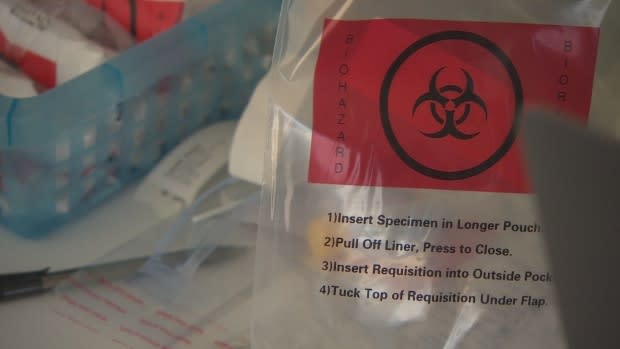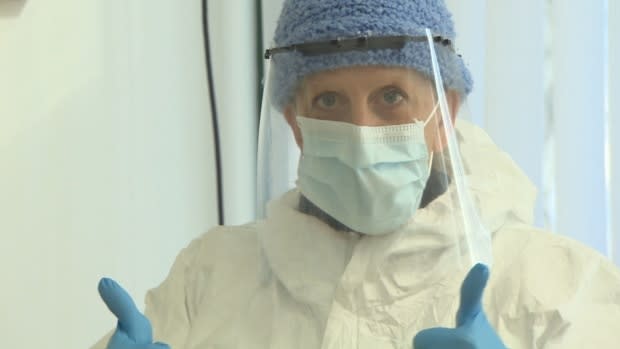Plenty of swabs but fewer people: Inside a drive-thru COVID-19 testing centre

After six weeks, the process is polished.
There's a gowned and face-shielded nurse waiting, clipboard in hand, as the cars pull into the parking lot behind General and Marine Hospital in Collingwood, Ont. Names are checked off, then a slow roll into the open-sided tent where two more PPE-wearing health care professionals stand ready to perform the COVID-19 test.
Window down. Engine off. A device to measure blood-oxygen levels is clipped onto the patient's finger, and their temperature is taken via a thermometer in the ear.
There's a short discussion about symptoms and how to access the test results online. Then out comes the sterile swab.
On this bright May morning last week, Dr. Karin Euler, looking more like a NASA rocket technician in her all-white coveralls, lets the patient choose which nostril. She instructs the woman to lean her head back and close her eyes, and warns that what's to come is uncomfortable.
WATCH | A patient gets tested for COVID-19 at a drive-thru testing centre in Collingwood, Ont.:
"I have to stay at the back wall of your nose, and I have to turn the swab five times. So you just got to hang in there," says Euler.
"God, that's horrible," Martha Bull exclaims once it's all over, comparing the experience to having a bee stuck up her nose.
Still, with a sore throat that's persisted for almost two weeks and fears of the novel coronavirus swirling in her mind, it's a trade-off that the 69-year-old is more than willing to make. She's worried not just about her own health but also for her sister and niece, with whom she shares her home.
"You know, it's really difficult to be in your own house — cooking, cleaning and looking after people, as well as looking after yourself — with a mask and gloves on all the time," she says.
Bull doesn't know anyone with COVID-19. Nor does she have any idea where she might have contracted the disease.
"I've been really, really careful," she says. "I went to the grocery store. I went to the liquor store. I got a coffee at a takeout place. That's it.
"But honestly ... where did I even get a cold?"
Testing 'essential': Trudeau
As Canada and other countries begin to grapple with what lies beyond lockdown, the push to ramp up testing is becoming more urgent, to establish the true extent of the COVID-19 pandemic and help dampen down future flare-ups of the disease.
"Massive rapid testing on a very wide-scale basis will be an essential part," of Canada's strategy Prime Minister Justin Trudeau declared last month, while Ontario Premier Doug Ford has made lagging testing numbers a focus of his daily media briefings, warning the province's regional medical officers to "start picking up your socks." And Alberta has just committed $4.5 million to try and raise its daily test numbers from 7,000 to 14,000.
Nationally, the country crested one million completed COVID-19 tests on Thursday.
But Canada remains far short of the 60,000-tests-per-day goal set by Chief Public Health Officer Dr. Theresa Tam, averaging approximately 25,000 daily tests over the past week, with the single-day record standing at 42,000 on April 30.
WATCH | Shortage of COVID-19 test kits limits testing capacity:
Meaning that at current rates it would take years to test all 37 million Canadians just once each.
Even that unprecedented accomplishment would be of limited use in the fight against COVID-19, notes Craig Jenne, a Canada research chair in infectious diseases at the University of Calgary.
"These [tests] really represent a snapshot in time. So somebody who is disease-free this morning may not be for the ride home," he says. "You want that assurance that nobody you come in contact with during the day has the virus. Otherwise your test may be meaningless within 24 to 48 hours."
Jenne calls Canada's current testing process, where swabs are shipped to labs and processed in batches, often taking days to return results to doctors and patients, a "logistical nightmare," further complicated by the scale of the outbreak and its geography. However, in the absence of a reliable quick blood test for either the disease or antibodies — or a vaccine — "it's better than nothing," he says.
Nowhere near capacity
Initially, logistics were the problem in Collingwood. Dr. Harry O'Halloran, who oversees the testing program here, said the hospital had just nine swabs on hand at one point in March. Today, he estimates that they have around 1,000 in stock, but the issue now is more about waning demand.
While parts of the country continue to grapple with supply, capacity or logistics issues, this testing facility in Collingwood has a different problem: fewer patients even though it's easier than ever to get tested.
"We're trying to set a lower threshold for testing, and if anyone has any symptoms whatsoever we tend to go ahead and test them," says O'Halloran. Patients can sign up online, be referred by their doctors or, in some cases, get tested just by showing up on their own.
This past week, all the residents of two local long-term care homes, several hundred people in total, were screened as well, but the hospital still hasn't come anywhere near its testing capacity, with the drive-thru handling 30 to 40 people a day. As the disease curve has flattened, so has the number of people coming to get tested.
All told, there have been more than 1,500 novel coronavirus tests completed in Collingwood so far, with 30 positive results, a rate of just under two per cent. One person has died — a man in his 70s who fell ill while travelling overseas. And four other COVID patients are currently being treated in the hospital.
Initially, says O'Halloran, the local cases were linked to foreign travel. Now, there are three categories: residents and staff who contracted the disease in long-term care centres, their close contacts and "unknowns."
"Most people at this point are community spread," says the doctor. "They are just getting it in the community somewhere. We don't know where for sure."
Cottagers on the way
Collingwood, a city of around 21,000 that is a ski-centre in the winter and a cottage destination in the summer, is bracing for an influx of out-of-towners as the weather warms. O'Halloran is sympathetic to those who want to escape their homes after close to two months of isolation, even as he acknowledges that it's likely to further complicate the local COVID-19 tracking efforts.
"We'd like to say to people to come and stay, not go back and forth," he says. "But certainly we anticipate that we will have lots of transient population."

Just before lunch hour on the day CBC News visited this drive-thru testing site, a blue Mazda rolled into the tent. Two young men were sitting up front, their faces masked.
Logan Crawley and Jamie Vu had been through the drill before. The fellow nursing students had been filling in as personal support workers at an area long-term care home when they contracted COVID-19, both testing positive in late April.
"I had night sweats...and then I developed a cough, headaches, chills," said 22-year-old Crawley. "Nothing serious. Not respiratory stuff."
Vu's only symptoms were a cough and a stuffy nose.
Both had been outfitted with full PPE at work and were washing their hands as instructed, and still managed to catch the disease.

Crawley and Vu both initially tested negative after their symptoms developed. They returned a few days later for additional swabs, at a doctor's insistence, and got positive results. Crawley's father and brother have also now been diagnosed with COVID. His mother has tested negative.
"I was definitely anxious about spreading it to other people ... especially my family, because you hear the stories about people having troubles with breathing and stuff like that," Crawley said. "It's a little worrying, trying to remember who you've been with and who you have talked with."
Now symptom-free, Crawley and Vu, 21, are both seeking to return to work, needing back-to-back negative tests over a 24-hour period for the all-clear.
It could be a risk. So little is known about the disease that researchers aren't yet sure if those who have had it are immune to further infection.
But Crawley said he feels duty-bound to return to the fray.
"It's just the aspect of taking care of people. Trying to help the people who are vulnerable. And trying to be there for them," he said. "Especially in nursing homes. They're not allowed any visitors at all."
Crawley and Vu have since received their results. Both are still positive for COVID-19.
Together, they have now been tested a total of eight times — a reminder that even as the number of samples processed rises, it doesn't necessarily mean that more people are being screened.
They'll be back at the COVID drive-thru later this week, hoping for better news.
WATCH the full story from The National | What happens at a drive-thru COVID-19 test centre:

 Yahoo Movies
Yahoo Movies 
